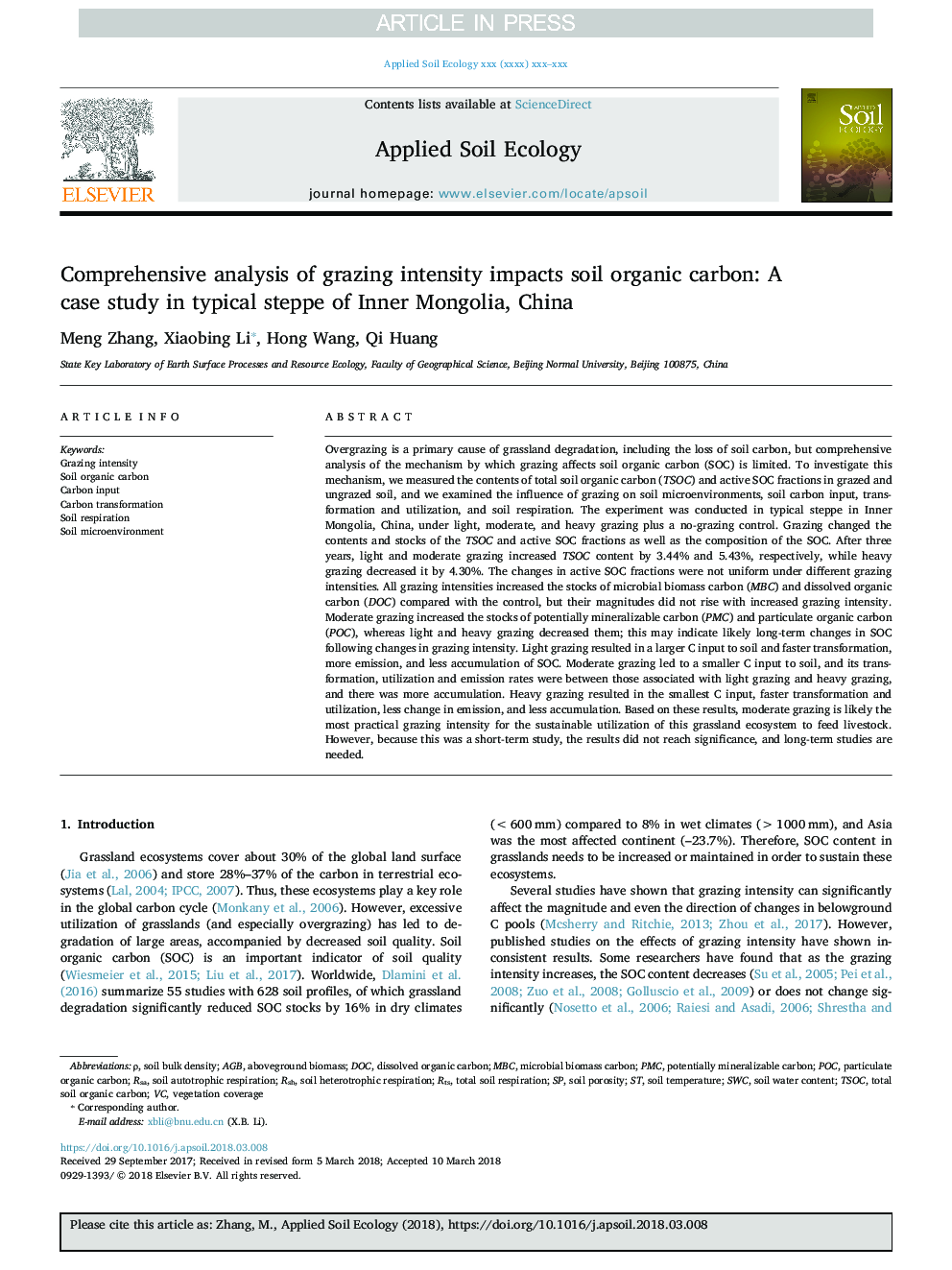| کد مقاله | کد نشریه | سال انتشار | مقاله انگلیسی | نسخه تمام متن |
|---|---|---|---|---|
| 8846586 | 1617754 | 2018 | 12 صفحه PDF | دانلود رایگان |
عنوان انگلیسی مقاله ISI
Comprehensive analysis of grazing intensity impacts soil organic carbon: A case study in typical steppe of Inner Mongolia, China
ترجمه فارسی عنوان
تجزیه و تحلیل جامع از شدت چرت زدن تاثیر کربن آلی خاک: مطالعه موردی در استپ معمولی مغولستان داخلی چین
دانلود مقاله + سفارش ترجمه
دانلود مقاله ISI انگلیسی
رایگان برای ایرانیان
کلمات کلیدی
SWCRSHPotentially mineralizable carbonTotal soil organic carbonTotal soil respirationRSAMBCDOCPMCRTSPOCCarbon transformationAboveground biomass - بیوماس زیرزمینیSoil porosity - تخلخل خاکSoil respiration - تنفس خاکsoil heterotrophic respiration - تنفس هتروتروفیک خاکSoil temperature - دمای خاکGrazing intensity - شدت گاوAGB - شرایطSoil water content - محتوای آب خاکCarbon input - ورودی کربنVegetation coverage - پوشش گیاهیSoil bulk density - چگالی فله خاکSoil organic carbon - کربن آلاینده خاکParticulate organic carbon - کربن آلاینده کربنDissolved organic carbon - کربن آلی حل شدهmicrobial biomass carbon - کربن زیست توده میکروبی
موضوعات مرتبط
علوم زیستی و بیوفناوری
علوم کشاورزی و بیولوژیک
بوم شناسی، تکامل، رفتار و سامانه شناسی
چکیده انگلیسی
Overgrazing is a primary cause of grassland degradation, including the loss of soil carbon, but comprehensive analysis of the mechanism by which grazing affects soil organic carbon (SOC) is limited. To investigate this mechanism, we measured the contents of total soil organic carbon (TSOC) and active SOC fractions in grazed and ungrazed soil, and we examined the influence of grazing on soil microenvironments, soil carbon input, transformation and utilization, and soil respiration. The experiment was conducted in typical steppe in Inner Mongolia, China, under light, moderate, and heavy grazing plus a no-grazing control. Grazing changed the contents and stocks of the TSOC and active SOC fractions as well as the composition of the SOC. After three years, light and moderate grazing increased TSOC content by 3.44% and 5.43%, respectively, while heavy grazing decreased it by 4.30%. The changes in active SOC fractions were not uniform under different grazing intensities. All grazing intensities increased the stocks of microbial biomass carbon (MBC) and dissolved organic carbon (DOC) compared with the control, but their magnitudes did not rise with increased grazing intensity. Moderate grazing increased the stocks of potentially mineralizable carbon (PMC) and particulate organic carbon (POC), whereas light and heavy grazing decreased them; this may indicate likely long-term changes in SOC following changes in grazing intensity. Light grazing resulted in a larger C input to soil and faster transformation, more emission, and less accumulation of SOC. Moderate grazing led to a smaller C input to soil, and its transformation, utilization and emission rates were between those associated with light grazing and heavy grazing, and there was more accumulation. Heavy grazing resulted in the smallest C input, faster transformation and utilization, less change in emission, and less accumulation. Based on these results, moderate grazing is likely the most practical grazing intensity for the sustainable utilization of this grassland ecosystem to feed livestock. However, because this was a short-term study, the results did not reach significance, and long-term studies are needed.
ناشر
Database: Elsevier - ScienceDirect (ساینس دایرکت)
Journal: Applied Soil Ecology - Volume 129, August 2018, Pages 1-12
Journal: Applied Soil Ecology - Volume 129, August 2018, Pages 1-12
نویسندگان
Meng Zhang, Xiaobing Li, Hong Wang, Qi Huang,
